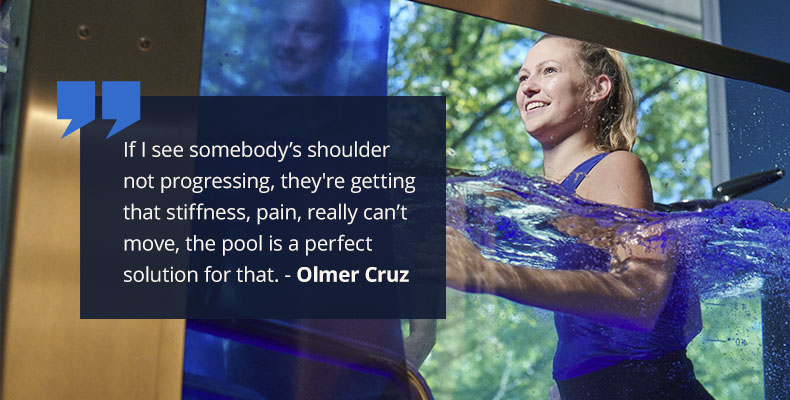Aquatic Therapy for Rotator Cuff Recovery
Rotator cuff tears are a common injury, although not everyone who tears their rotator cuff may realize it right away. Patients who tear their rotator cuff may experience pain and loss of mobility in their arm, especially when raising it over their head. Thankfully, there are many options for shoulder injury treatment so individuals can reduce pain and regain mobility.
With a combination of physical therapy, rest and pain medication, most people recover full function of their shoulder and arm. In some cases, surgery can also help. Keep reading to learn how aqua therapy can help your patients heal from a rotator cuff tear.
What Is a Rotator Cuff Tear?
A rotator cuff tear happens when the tendon that attaches a patient’s arm to their shoulder becomes damaged. Depending on the severity of the damage, this tendon may tear a little or completely separate from the bone. Some people have a higher risk of a rotator cuff tear, depending on their genetics or occupation. Although a rotator cuff tear can result from an accident, it often happens because of repetitive motion over time.
Here are some common symptoms of a rotator cuff tear:
- Dull ache or sharp pains in shoulder
- Weakness in arm and shoulder
- Loss of shoulder mobility
- Difficulty lifting the arm
- Trouble sleeping from the discomfort
This tendon may not completely heal without surgery. However, patients can mitigate the damage and protect themselves from future tearing with physical therapy for their rotator cuff.
Physical Therapy for Rotator Cuff Tear Recovery
To help their shoulder heal, patients need to reduce the swelling and allow their tendon to rest. If patients pursue physical therapy, they’ll heal faster and can go back to work and life more quickly. Patients who have surgery will need much longer to recover. Although the surgery itself is minimally invasive, recovery times can take a year or longer.
Most people recover mobility and relieve pain without surgery. If you want to enhance a patient’s physical therapy experience, consider using aquatic therapy for rotator cuff repair. The warm temperature of the water will relax their muscles and help reduce inflammation during exercises. Water provides a supportive environment that also allows for muscle resistance and retraining.
Rotator Cuff Tear Case Study
Want to learn more about the benefits of aquatic therapy for rotator cuff rehab? Check out this case study.
For 69-year-old Charles, a patient at Peak Performance in Lynbrook, NY, wear and tear of his rotator cuff weakened his joint and eventually required him to undergo surgery. Four weeks after his surgery, Charles started his rehabilitation by participating in aqua therapy with aquatic therapist Olmer Cruz from Peak Performance, using the HydroWorx 500 Series Pool.
Cruz sums it up by stating there are two motions that the muscle makes when attempting to rotate the shoulder. The first motion is the muscle being placed inside the socket. Once the muscle is placed, the arm can then be lifted up as part of the second motion. When performing aqua therapy, the water eliminates the need for the first step. As the patient enters the pool, the water guides the muscle into the socket. Therefore, all the patient needs to do is develop the strength to lift their arm in an upward and downward motion.

“If I see somebody’s shoulder not progressing, they’re getting that stiffness, pain, really can’t move, the pool is a perfect solution for that” -Olmer Cruz
Throughout the therapy, Cruz offers multiple exercises and tips for faster and healthier rehabilitation. One of the many benefits of rehabilitation in water is how the warm water actually relaxes the muscles while decreasing the pain. An important factor to remember for the patient is to keep the shoulder underwater while performing the exercises to allow for faster healing and a proper procedure.
The beauty of performing these exercises underwater is that Charles can do any exercise he would on land without the shoulder pain and discomfort. Protocols that couldn’t be performed on land due to pain levels or inabilities are done in water with much greater ease. Here are a few common aquatic exercises for rotator cuff injuries:
- Forward and backward circle motions
- Utilizing paddles for upward and downward motions at a 90-degree angle with resistance
- Standing patients at an angle to perform exercises, allowing for 120-degree motion
- Bicep and tricep curls with resistance
- Wall push-ups
When performed underwater, these exercises can help strengthen important muscle groups. Patients who use aquatic therapy see many benefits and have reduced pain during physical therapy sessions. Another advantage to using aquatic therapy technology is deep tissue massage. For rotator cuff rehabilitation in the pool, Cruz looks to accomplish four things with the underwater massage using the resistance jets and massage hose:
- Take away the pain from the patient.
- Increase the patient’s range of motion.
- Increase the patient’s strength.
- Get the patient back into a normal life.
Interested in aquatic therapy for rotator cuff rehabilitation? Reach out to learn more!


